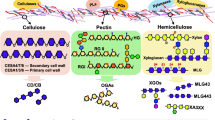Abstract
RHIZOBIA are symbiotic bacteria that elicit the formation on leguminous plants of specialized organs, root nodules, in which they fix nitrogen1. In various Rhizobium species, such as R. leguminosarum and R. meliloti, common and host-specific nodullation (nod) genes have been identified which determine infection and nodulation of specific hosts1. Common nod ABC genes2–5 as well as host-specific nodH and nodQ genes4'6–8 were shown recently, using bioassays, to be involved in the production of extracellular Nod signals. Using R. meliloti strains overproducing symbiotic Nod factors, we have purified the major alfalfa-specific signal, NodRm-1, by gel permeation, ion exchange and C18 reverse-phase high performance liquid chromatography. From mass spec-trometry, nuclear magnetic resonance, 35S-labelling and chemical modification studies, NodRm-1 was shown to be a sulphated β-1,4-tetrasaccharide of D-glucosamine (Mr 1,102) in which three amino groups were acetylated and one was acylated with a C16 bis-unsaturated fatty acid. This purified Nod signal specifically elicited root hair deformation on the homologous host when added in nanomolar concentration.
Similar content being viewed by others
References
Long, S. R. Cell 56, 203–214 (1989).
van Brussel, A. A. N. et al. J. Bact. 165, 517–522 (1986).
Zaat, S. A. J., van Brussel, A. A. N., Tak, T., Pees, E. E. & Lugtenberg, B. J. J. J. Bact 169, 3388–3391 (1987).
Faucher, C. et al. J. Bact. 170, 5489–5499 (1988).
Schmidt, J., Wingender, R., John, M., Wieneke, U. & Schell, J. Proc. natn. Acad. Sci. U.S.A. 85, 8578–8582 (1988).
Banfalvi, Z. & Kondorosi, A. Plant molec. Biol. 13, 1–12 (1989).
Faucher, C. et al. Molec. Plant-Microbe Interact. 2, 291–300 (1989).
Faucher, C. et al. in Signal Molecules in Plant and Plant-Microbe Interactions (ed. Lugtenberg, B. J. J.) 379–386 (Springer–Verlag, Berlin/Heidelberg, 1989).
Truchet, G., Michel, M. & Dénarié, J. Differentiation 16, 163–173 (1980).
Finan, T. M. et al. Cell 40, 869–877 (1985).
Truchet, G. et al. Molec. gen. Genet. 219, 65–68 (1989).
Debellé, F. et al. J. Bact. 168, 1075–1086 (1986).
Cervantes, E. et al. Molec. Microb. 3, 745–755 (1989).
Peters, N. K., Frost, J. W. & Long, S. R. Science 233, 977–980 (1986).
Mulligan, J. T. & Long, S. R. Genetics 122, 7–18 (1989).
Blumberg, K., Liniere, F., Pustilnik, L. & Bush, C. A. Analyt. Biochem. 119, 407–412 (1982).
Zeroni, M. & Hall, M. A. in Hormonal Regulation of Development I, Molecular Aspects (ed. MacMillan, J.) 511–586 (Springer-Verlag, Berlin/Heidelberg, 1980).
Raetz, C. R. H. in Escherichia coli and Salmonella typhimurium Cellular and Molecular Biology (ed. Neidhardt, F. C.) 498–503 (Am. Soc. Microbiol., Washington, 1987).
Darvill, A. G. & Albersheim, P. A. Rev. Pl. Physiol. 35, 243–298 (1984).
Diaz, C. L., Melchers, L. S., Hooykaas, P. J. J., Lugtenberg, B. J. J. & Kijne, J. W. Nature 338, 579–581 (1989).
Lis, H. & Sharon, N. A. Rev. Biochem. 55, 35–67 (1986).
Kijne, J. W., Diaz, C. L. & Lugtenberg, B. J. J. in Signal Molecules in Plant and Plant-Microbe Interactions (ed. Lugtenberg, B. J. J.) 351–358 (Springer, Berlin/Heidelberg, 1989).
Vincent, J. M. A Manual for the Practical Study of Root-Nodule Bacteria. IBP Handbook no. 15 (Blackwell Scientific Publications, Oxford, 1970).
Dell, A. et al. Carbohydr. Res. 179, 7–19 (1988).
Dell, A. Adv. Carbohydr. Chem. Biochem. 45, 19–72 (1987).
Demary, M., Puzo, G. & Asselineau, J. Nouv. J. Chimie 2, 373–378 (1977).
Promé, J. C., Aurelle, H., Couderc, F. & Savagnac, A. Rapid Commun. Mass Spectrom. 1, 80–82 (1987).
Finne, J., Krusius, T. & Rauvala, H. Carbohydr. Res. 80, 336–339 (1980).
Boyd, J., Porteous, R. & Soffe, N. Carbohydr. Res. 139, 35–46 (1985).
Strecker, G., Wieruszeski, J. M., Martel, C. & Montreuil, J. Carbohydr. Res. 185, 1–13 (1989).
Author information
Authors and Affiliations
Rights and permissions
About this article
Cite this article
Lerouge, P., Roche, P., Faucher, C. et al. Symbiotic host-specificity of Rhizobium meliloti is determined by a sulphated and acylated glucosamine oligosaccharide signal. Nature 344, 781–784 (1990). https://doi.org/10.1038/344781a0
Received:
Accepted:
Issue Date:
DOI: https://doi.org/10.1038/344781a0
- Springer Nature Limited
This article is cited by
-
Identification of QTLs for symbiotic nitrogen fixation and related traits in a soybean recombinant inbred line population
Theoretical and Applied Genetics (2024)
-
Efficient and versatile formation of glycosidic bonds via catalytic strain-release glycosylation with glycosyl ortho−2,2-dimethoxycarbonylcyclopropylbenzoate donors
Nature Communications (2023)
-
FER meets the Nod factor pathway
Nature Plants (2023)
-
GmbZIP1 negatively regulates ABA-induced inhibition of nodulation by targeting GmENOD40–1 in soybean
BMC Plant Biology (2021)
-
Phylogenetic diversity analysis reveals Bradyrhizobium yuanmingense and Ensifer aridi as major symbionts of mung bean (Vigna radiata L.) in Pakistan
Brazilian Journal of Microbiology (2021)





